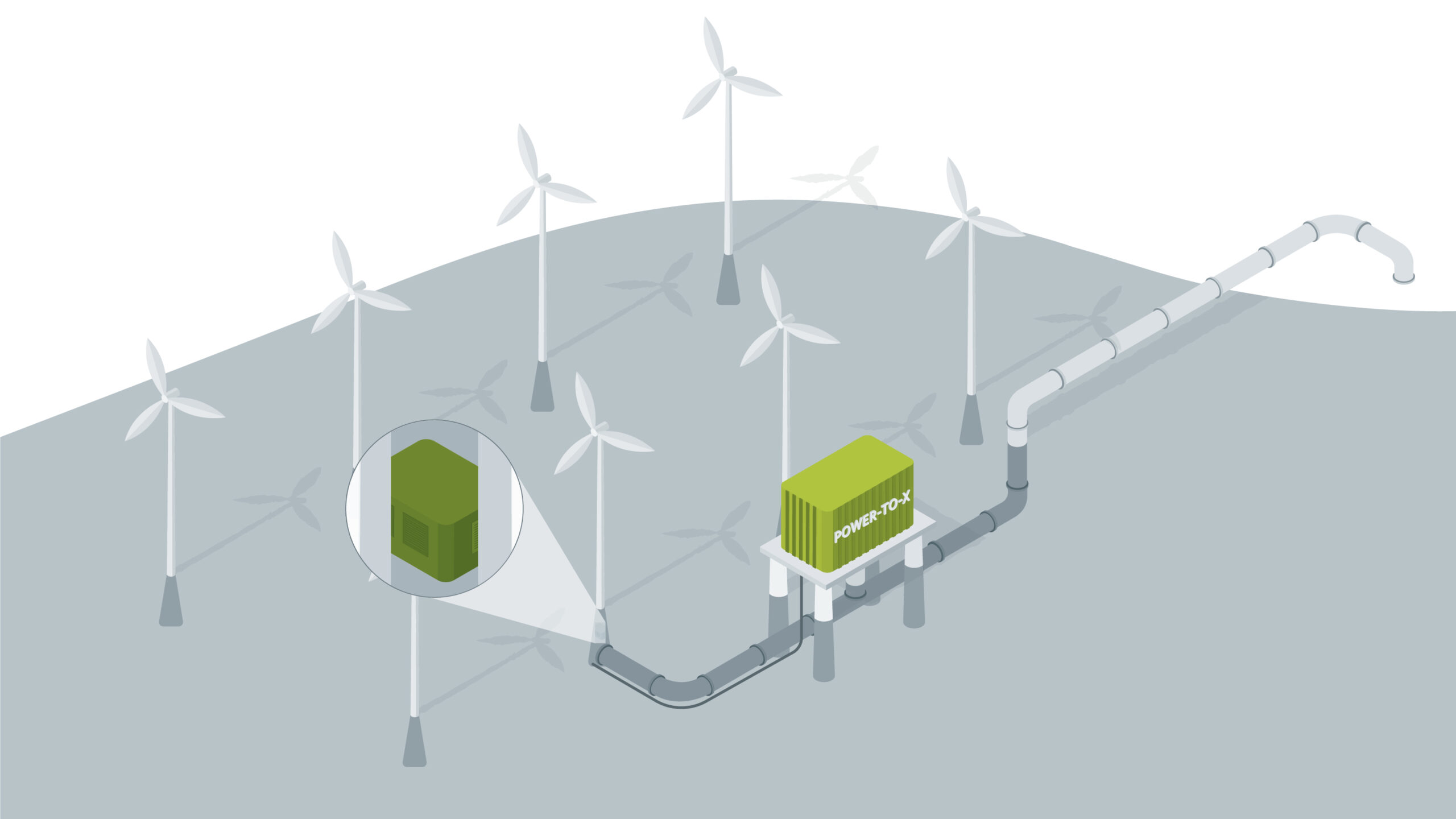PROJEKTE
 Quelle: Projektträger Jülich im Auftrag des BMBF.
Quelle: Projektträger Jülich im Auftrag des BMBF.
H2Mare – Grüner Wasserstoff vom Meer
Für den erfolgreichen Markthochlauf von grünem Wasserstoff, muss dieser kostengünstig erzeugt werden. Offshore-Windenergie kann in diesem Kontext ein gutes Instrument bieten, um günstigen grünen Wasserstoff herzustellen – insbesondere dann, wenn der Wasserstoff direkt vor Ort ohne kostenintensive Infrastruktur produziert werden kann. Genau dies wird aktuell im vom Bundesministerium für Bildung und Forschung (BMBF) geförderten Wasserstoff Leitprojekt „H2Mare“ untersucht.
Offshore-Windenergieanlagen bieten ein großes Potenzial für die kostengünstige Erzeugung von erneuerbaren Energien – und damit auch für die Produktion von günstigem grünem Wasserstoff. Im Vergleich zu Windanlagen an Land bieten Offshore-Windräder eine höhere durchschnittliche Nennleistung und erzeugen Strom vergleichsweise kontinuierlich. Diese Vorteile sollen im Rahmen des Projekts H2Mare dazu genutzt werden, direkt vor Ort auf See kostengünstigen grünen Wasserstoff herzustellen. Aufgrund der lokalen Erzeugung mittels Windstrom können die Infrastrukturkosten – und damit auch die Kosten für den grünen Wasserstoff insgesamt – deutlich gesenkt werden.
Geplant ist neben der Erzeugung von grünem Wasserstoff auf See, auch die Produktion von Folgeprodukten wie grünem Methanol oder grünem Ammoniak, die flexibel eingesetzt und transportiert werden können. Hierzu wollen die Projektpartner den Einsatz von Technologien testen, welche die Kohlendioxid- und Stickstoffgewinnung auf See ermöglichen – eine Voraussetzung für die Herstellung von grünem Methanol und grünem Ammoniak.
Zudem sollen zukunftsfähige Ansätze wie die Meerwasser- oder Wasserdampf-Elektrolyse getestet und weiter vorangetrieben werden, da hierdurch die Entsalzung des Meerwassers – und damit ein weiterer Produktionsschritt – entfallen könnte. Aufgrund der Arbeit in einem sensiblen Ökosystem steht auch die Sicherheit und die Frage nach möglichen Umweltauswirkungen im Zentrum der Forschungsarbeiten.
 Quelle: Projektträger Jülich im Auftrag des BMBF.
Quelle: Projektträger Jülich im Auftrag des BMBF.
Die Umsetzung erfolgt dabei in vier Teilprojekten:
„OffgridWind“
Im Projekt „OffgridWind“ sollen die Voraussetzungen geschaffen werden, um einen Elektrolyseur in einer neuen Windanlage zu integrieren. Hierfür ist nicht nur ein anderes Fundament nötig als bei „herkömmlichen“ Offshore-Anlagen, sondern auch eine neue Windturbinenbauart.
„H2Wind“
Im H2Mare-Projekt „H2Wind“ wird der Elektrolyseur untersucht, der in den Anlagen zum Einsatz kommen soll. Ziel ist es, dass der eingesetzte Wasser-Elektrolyseur letztlich sehr effizient und nahezu autark arbeiten kann.
„PtX-Wind“
Im dritten Teil-Projekt „PtX-Wind“ steht die Power-to-X-Technologie im Mittelpunkt und dabei insbesondere die Produktion von grünem Methanol und grünem Ammoniak. Hierzu sollen CO2 und Stickstoff vor Ort aus der Luft gewonnen werden, die für die Produktion von Methanol und Ammoniak nötig sind. Im Rahmen des PtX-Wind-Projekts wird zudem die Meerwasserelektrolyse untersucht: Hierdurch soll das aus dem Meer gewonnene Wasser direkt bei der Elektrolyse genutzt werden können – sodass eine Entsalzung nicht mehr nötig wäre.
„TransferWind“
Im letzten H2Mare-Projekt „TransferWind“ geht es um übergeordnete Fragestellungen wie Sicherheits- und Umweltfragen oder Infrastrukturanforderungen auf See. Zudem sollen in diesem Teil-Projekt die Ergebnisse aus den anderen Projekten zusammengeführt werden und ein Austausch zwischen den vielfältigen Projektpartnern stattfinden.
Weitere Informationen
Aus Niedersachsen nehmen zwei Forschungseinrichtungen an dem vom Bundesministerium für Bildung und Forschung (BMBF) geförderten Projekt teil. Hierzu zählt neben der Leibniz Universität Hannover auch die Stiftung Offshore-Windenergie aus Varel.
Mehr zum Projekt finden Sie hier.
Bleiben Sie informiert – mit unserem Newsletter „NWN direkt…“
Sie möchten über diese und andere spannende Wasserstoff-Projekte aus Niedersachsen informiert bleiben? Dann melden Sie sich bei unserem Newsletter an!
